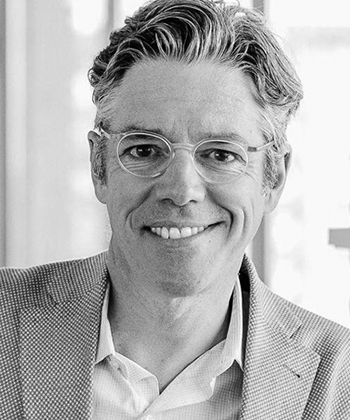ABOUT | REGISTRATION| SPONSORS| PROGRAM | SPEAKERS | FAQ

The RAIC’s Annual Conference on Architecture is an important gathering for the profession in Canada. As the state of our day-to-day lives continues to shift and we adapt to new realities, the RAIC’s commitment to supporting the practice remains a top priority. The RAIC has therefore transitioned its annual conference to a virtual platform. With the success of the live broadcast, the RAIC Virtual Conference on Architecture is now available on-demand!
Join your colleagues and peers in a virtual learning and networking experience. The RAIC Virtual Conference on Architecture brings together professionals at every stage in their career to learn, explore, and discuss the challenges and opportunities facing the practice. The virtual program offers eighteen hours of structured learning in a flexible format. Participants will learn from industry-leading experts through educational sessions on a diverse range of topics. While 12 of the sessions are now available, the 6 broadcasted session will be made available June 18.
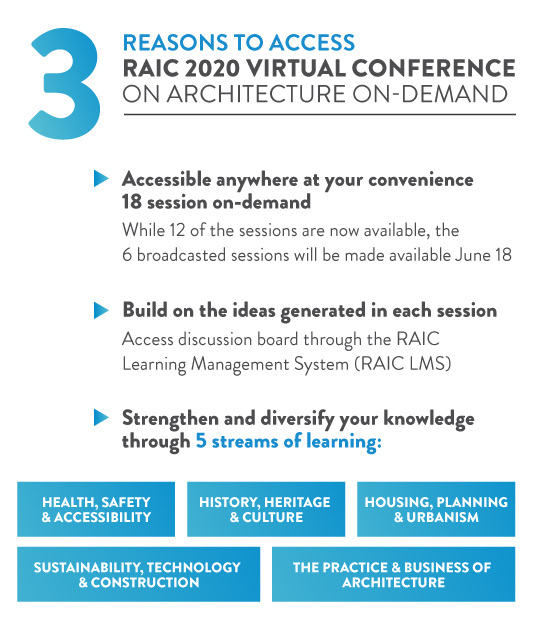

REGULAR | STUDENT| INTERN | RETIRED
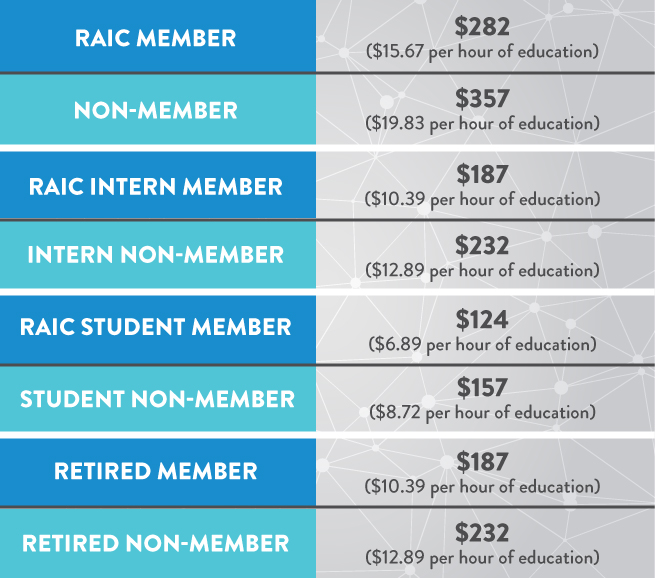

Canadian Architecture Forums on Education: Toward an Architecture Policy for Canada
Live Broadcast | 1 CEU
History, Heritage and Culture
June 4, 2020
11:00 a.m. – 12:00 p.m. EDT
This session will share outcomes of a year-long consultation process involving students and professors from all 12 Canadian schools of architecture. Beginning in Fall 2019, a series of forums were held to gauge and debate aspirations and concerns of the next generation of design professionals. Led by the Canadian Council of University Schools of Architecture (CCUSA), these Canadian Architecture Forums on Education (CAFÉs) were established to help define the tone and tenets of a national architecture strategy. Through presentation and interactive demonstration of consultation processes, RAIC participants will explore the role of education and research in shaping Canada’s architectural future.
Presented by:
Lisa Landrum
B.Arch, M.Arch2, PhD, MAA, AIA, FRAIC
Associate Professor, Associate Dean, University of Manitoba
Canada Declares – How Canadian Architects can begin to address the challenge of halving our annual emissions by 2030.
Live Broadcast | 1 CEU
Sustainability, Technology and Construction
June 4, 2020
12:30 p.m. – 1:30 p.m. EDT
The climate challenge we face is overwhelming and complex. Our industry’s emissions currently account for 40% of total global annual emissions. To meet the 2030 challenge we must radically refocus that effort into our biggest contributor to carbon emissions over the coming decade – embodied carbon. Collectively we need to face new questions: How do we now choose between two different window options, two doors, two walls, two structural systems? Assuming both options perform and cost the same, does either contain minerals and materials that were sustainably sourced, processed and transported? Was either sourced and made with fair labour? Does either option have half the carbon footprint of the industry norm? What is the norm? This panel will address the most pressing question of our profession, and provide theoretical, technical and policy background to enable participants to address this challenge.
Presented by:
Kelly Alvarez Doran
M.Arch, OAA
Senior Principal, MASS Design Group
Anthony Pak
P.Eng., MSc.
Principal, Priopta
Housing Academic Communities – Designing Exceptional Environments for Student Living
Live Broadcast | 1 CEU
Housing, Planning and Urbanism
June 4, 2020
2:00 p.m. – 3:00 p.m. EDT
Student housing has the ability to impact academic performance and influence future success. Learn how student residence design is responding to economic and cultural change to create inspiring environments that foster a sense of community and fellowship.
Drawing on the experience of delivering more than 10,000 residence beds across Canada, including two recent projects in Edmonton, this typology case study highlights architectural innovation both in new construction and adaptive reuse to create hubs of student activity that anticipate the collaborative environment of today’s workplace. Design issues of privacy, security, even managing the pervasive presence of digital devices will be discussed.
Presented by:
Ana Maria Llanos
M. Arch. Architect AIBC OAA RAIC LEED AP
Principal, Diamond Schmitt Architects
Gary Watson
B.Tech.Arch BEDS M.Arch, OAA, MRAIC
Senior Associate, Diamond Schmitt Architects
Avoiding Burn Out
Live Broadcast | 1 CEU
Health, Safety and Accessibility
June 4, 2020
4:00 p.m. – 5:00 p.m. EDT
This session is presented by the RAIC Emerging Practitioners (RAIC EP).
For many of those in the architectural profession, long hours and build up of stress is an accepted reality. Owners of firms, along with their employees, can feel overwhelmed by the shear number of tasks and concerns which must be juggled on any given day – from financial concerns relating to running a practice to general project issues- which can lead to burn out and other mental health issues. This session will review the main causes of burn out – not just for the owner of a practice but to all those working in a firm – and discuss how to avoid and address it. The presentation will share both research data as well as anecdotal information garnered via a series of interviews. Mental health is a serious issue in the architectural profession and this session aims to shed light on the topic while encouraging more open discussion.
Presented by:
Ksenia Eic
NWTAA, OAA, MRAIC
Managing Associate, Taylor Architecture Group
RAIC EP Committee Member
Architecture, Anthropology and Social Acceptance: Design that Created Zones of Acceptance in Vancouver’s Downtown Eastside
Live Broadcast | 1 CEU
Health, Safety and Accessibility
June 4, 2020
5:30 p.m. – 6:30 p.m. EDT
This presentation documents a series of community-based design initiatives dating from 2001 to the present day, spear-headed by the Portland Hotel Community Services Society, that deliver a comprehensive response to the needs of individuals living on the margins in Vancouver with multiple barriers to their psycho-social well-being — including poverty, injection drug use, HIV/AIDS, HCV, trauma, homelessness, conflict with the law, mental illness, and survival sex trade involvement.Architect Sean McEwen and Anthropologist Dr. Dan Small, will describe such design collaborations as InSite, North America’s first supervised injection facility, OnSite, a detox without barriers, and other social service and social entrepreneurial initiatives that serve the local community. In total, these projects have facilitated the creation of a zone of acceptance for the marginalized in Vancouver’s Downtown Eastside, and may serve as an example of how other urban centres can respond to a range of significant social challenges.
Presented by:
Sean McEwen
Architect aibc fraic
Architect, S.R. McEwen Architect
Dan Small
PhD, MPhil. Cantab., BA Soc/Anth Hon, BA Psych. Hon
Medical Anthropologist, University of British Columbia
Rise for Architecture
Live Broadcast
History, Heritage and Culture
June 4, 2020
7:00 PM- 8:00 PM EDT
This presentation and discussion will discuss a current collaborative initiative of the Canadian Architectural Licensing Authorities (CALA), the Canadian Council of University Schools of Architecture (CCUSA) and the Royal Architectural Institute of Canada (RAIC) focused on the development and implementation of an Architecture Policy for Canada. The session will include discussion of the consultation feedback received to date, provide an overview of the emerging vision statement and discuss calls to action for the profession.
Presented by:
Darryl Condon
Architect, AIBC, AAA, SAA, OAA, NLAA, AIA, FRAIC, LEED AP
Managing Principal, HCMA Architecture + Design
On-Demand Sessions
Creating a Legacy with Transit Architecture: Lessons Learned
On-Demand | 1 CEU
Housing, Planning and Urbanism
How can architects design great transit infrastructure that preserves built heritage and creates a legacy?
The growing demand for the expansion of transit infrastructure asks architects to address the heritage of the City today while designing a legacy for future generations. This session will focus on three case studies: the Eglinton Crosstown LRT stations that are adjacent to- or within heritage buildings; the London, Ontario BRT which used community consultations to determine the heritage components of new stations; and Finch West which integrated Public Art into its design. The session will provide insight on the balance required to consider both legacy and preservation.
Presented by:
Ana-Francisca de la Mora
MRAIC, OAA ARQ, LEED AP BD+C
Associate Director – Practice Lead, Architecture, IBI Group
Cybersecurity: Mitigating Risks and Protecting data
On-Demand | 1 CEU
The Practice and Business of Architecture
Architectural firms have tremendous motivation to protect their digital data, however many organizations do not take the proper steps to mitigate these risks. This presentation will discuss some common methods that attackers utilize to gather information before launching an attack, why it is important for organizations to consider the security of their digital data, and how to mitigate these risks.
Presented by:
Ryan Duquette
Licensed private investigator, Masters of Science (Digital Forensics Management), Certified Fraud Examiner
Partner – Security, Privacy and Risk Consulting, RSM Canada
Filling in the Blanks: Missing Middle Infill Design Competition
On-Demand | 1 CEU
Housing, Planning and Urbanism
Endorsed by the Alberta Association of Architects (AAA), the Missing Middle Infill Design Competition drew 30 proposals from teams of architects and builders/developers from across Canada and as far away as London, UK. Their task: design a multi-unit, ‘missing middle’ housing development that was not only thoughtful of neighbourhood context, but also economically feasible and well-designed to work in Edmonton. An esteemed National Jury Panel from across Canada reviewed the proposals and awarded first, second and third place honours to the top finalists. The winning team has acquired the right to purchase five parcels of City-owned land at the northeast corner of 112 Avenue and 106 Street in the Spruce Avenue neighbourhood and build their winning design, subject to rezoning approval. The Infill Design Competition is one of many ways the City is working to help encourage more and better infill in Edmonton. The competition is part of action five on the Edmonton Infill Roadmap 2018, the City of Edmonton’s work plan for welcoming more people and homes into Edmonton’s older neighbourhoods to help keep these neighbourhoods vibrant and healthy. The City Plan, which will be completed in 2020, will set out the choices that will help our city grow to a city of two million people, and reach the goal of creating vibrant urban communities. A big part of reaching this goal will involve increasing housing choices, particularly how we can integrate more housing in the ‘missing middle’ range. A panel featuring the City of Edmonton (City Planning, Development and Zoning Services, Real Estate, Law, Communications), the winning design team (Studio North, Gravity Architecture, Part + Parcel, and the Spruce Avenue Community League will share lessons learned on how the competition drew in well-designed, economically feasible designs — and how the process employed helped to attract interest from across the country, to fortify community support, and to ensure the winning design would be built.
Presented by:
Jason Syvixay
Master of City Planning
Principal Planner, City of Edmonton
Joshua Culling
Master of Urban Planning
Urban Planner and Community Advisor
Hazel Borys
Chief Executive Officer
PlaceMakers, Inc.
James Sande
AACI Senior Strategist, Land Governance, Real Estate, City of Edmonton
Karen Parker
Manager of Business Analytics, City of Edmonton
Mark Erickson
Principal, Studio North
Inclusive Design in the Federal Government
On-Demand | 1 CEU
Health, Safety and Accessibility
With the amendment to the “Canadian Human Rights Act” and the creation of Canada’s first federal accessibility legislation “Accessible Canada Act” the federal government has a focused interest on inclusive design for all. This session will focus on the built environment, how the legislation is interpreted with respect to gender neutral facilities; such as, washrooms, change rooms and showers. The presentation will share research and development by federal government departments, stakeholder engagements and lessons learned from implementation of respectful universally inclusive facilities.
Presented by:
Murray Gallant
OAA, FRAIC, AIA, B.Arch., H.Dipl. Arch. Tech.
Chief Architect, National Defence
Robert J Smith
OAA, RAIC
Architectural Advisor, House of Commons
Parametric Design: The Past and the Future
On-Demand | 1 CEU
Sustainability, Technology and Construction
Parametric Design has often been reduced to merely Parametricism which is a self-referential system using internal mathematical equations translated into computer algorithms to create fashionable and complex forms that has only a little, if any, input from the real-world parameters. On the contrary, Parametric Design is neither new in architecture history nor limited to computational formal extravagance. It is a way of thinking that was used in the past, like analogue models by Gaudi, and should be further studied to find ways to better incorporate environmental, social, structural, and geographical parameters in architecture models using algorithms and real-world data.
Presented by:
Reza Assasi
PhD (Architecture), MArch II, MArch, OAA
Architect, Professor, Centennial College
Restore, Renew, Revitalize: Working With Canada’s Modern Heritage
On-Demand | 1 CEU
History, Heritage and Culture
Canada’s modern buildings represent a significant attempt to forge a national identity and a vital architectural legacy for the country. As these buildings enter their next 50 years of service, however, many are in need of significant modernization. Through case studies of five significant projects, this session explores the conceptual, technical, and logistical challenges particular to working in buildings of this era. Case studies include:
-
Viljo Revell’s Nathan Phillips Square
-
Arthur Erickson’s Bank of Canada Headquarters
-
Ron Thom’s Bata Library
-
John Andrews’ Weldon Library
-
Dimitri Dimakopoulos’ Place du Portage Complex
Presented by:
Andrew Frontini
OAA, NSAA, FRAIC, LEED® AP BD+C
Principal, Design Director, Perkins and Will
Jon Loewen
OAA, MRAIC, LEED® AP BD+C, Certified Passive House Designer
Associate, Senior Architect, Perkins and Will
Soundscape, Human Perception, and the Built Environment
On-Demand | 1 CEU
Health, Safety and Accessibility
Noise is an essential sensory stimulus and impossible to ignore. Any disturbing noise can be agitating and confusing. Soundscape refers to the human perception of the auditory environment in context; it relies on the subjective quality of sound and the objective quality of the auditory environment based on people’s perception. We design a space based on the idea that users have the same perception of the space as we intended. Not everyone, however, has the same capability to perceive the space. This session introduces the concept of the soundscape and how to conduct a soundscape study and evaluate the outcome.
Presented by:
Arezoo Talebzadeh
OAA, NCARB, MRAIC
Architect, Kasian
Spaces, People, Things: Environments for People Living with Dementia
On-Demand | 1 CEU
Health, Safety and Accessibility
How can we improve quality of life for people with dementia where they live? As researcher-in-residence in a care facility, Lara Pinchbeck uses findings from an extensive international University of Alberta research study to provide insight and influence on design to change the daily life for aging adults with dementia. Learn how elements from these findings will make a healthy and happy environment for people aging-in-place. A model of the material environment will be presented as the basis to shift the design process beyond the four walls. The session will also highlight current examples of practical applications.
Presented by:
Lara Pinchbeck
MA (Material Culture + Design Studies), BEDS (Architecture), Professional Human Ecologist, Rick Hansen Foundation Professional Accessibility Assessor, Public Relations Diploma, International Association for Public Participation Certification, PRINCE2 Proj
Founder + Principal; PHD Student, Lara Pinchbeck: Research+Design; University of Alberta
Charles Olfert
Architect AAA, SAA, FRAIC, LEED AP
Principal, aodbt architecture + interior design
Walterdale Bridge: the making of a destination to ‘Touch the Water’
On-Demand | 1 CEU
Housing, Planning and Urbanism
How do you make an infrastructure project, a replacement bridge, a public place? The Walterdale Bridge project team sought to answer this question through a unique design process bringing together architects, engineers, urban designers, landscape architect and artists to realize the potential of this incredible location in Edmonton’s Saskatchewan River Valley. The new bridge, a gracious single span arch, has quickly become a landmark and a gateway to the City’s downtown. But it is more than a bridge across a river. By integrating the bridge with a passerelle, connecting to the river valley trail system, intertwining nature, history and art an engaging public place is created, a destination on the river; where the duality of city and nature are experienced and celebrated.
Presented by:
Donna Clare
AAA, OAA, FRAIC, RCA
Principal, DIALOG
Doug Carlyle
BES, M LAND ARCH, AALA, FCSLA, ASLA (International), RCA
Principal, DIALOG
Dr. James Montgomery
AAA, OAA, FRAIC, RCA
Principal, DIALOG
Your Building. Our Collective Future.
On-Demand | 1 CEU
Health, Safety and Accessibility
Over 20% of Canadian adults identify as having a disability, and this number is rising as our population ages. 70% of Canadians believe that all new buildings should be universally accessible. The usual approach to setting the level of accessibility of the built environment often relies on minimum requirements, such as building code. This does not meet the needs of all its users. The Rick Hansen Foundation Accessibility Certification™ (RHFAC) is the only national program that rates and certifies the built environment on its level of meaningful access, ensuring everyone has access to the places where we live, work, learn, and play. This session will leave you understanding the critical role you play in rethinking how we design the built environment, along with practical information on how you can design spaces for everyone, everywhere.
Presented by:
Darryl Condon
Architect, AIBC, AAA, SAA, OAA, NLAA, AIA, FRAIC, LEED AP
Managing Principal, HCMA Architecture + Design
When Architects Design for Themselves
On-Demand | 1 CEU
History, Heritage and Culture
Throughout architecture school, we all dream of the great projects and designs we will accomplish upon graduation. Then the reality of budgets, client preconceptions and zoning by-laws start to nibble at the margins of the great design. But, when architects design for themselves, we take back full ownership of that dream. This session explores case studies and lessons-learned when the architect is designer, critic, client and occupant.
Presented by:
Terrence E. Smith-Lamothe
MRAIC, NSAA, M.Arch., B. Env. S., B. Sc., LEED a.p.
Architect, Architech, Ltd.
Designing for Community Wellbeing
On-Demand | 1 CEU
Health, Safety and Accessibility
The built environment is intricately tied with the wellbeing of people and the environment. With this idea, though well intended, most architects, planners, and designers operate from a place of intuition. This session will review an evidence-based methodology and set of indicators developed by the Conference Board of Canada (and others) intended to guide the work of design-professionals and city-builders. The Community Wellbeing Framework embraces a proactive approach to wellbeing, including mental health, social wellbeing, and contextual nuances. Following a presentation, participants will be able to workshop the fundamentals to elucidate ways of enriching their individual practices.
Presented by:
Antonio Gomez-Palacio
Arq. MES, RPP, MCIP, FRAIC
Principal, DIALOG

Ana Maria Llanos
M. Arch. Architect AIBC OAA RAIC LEED AP
Principal, Diamond Schmitt Architects
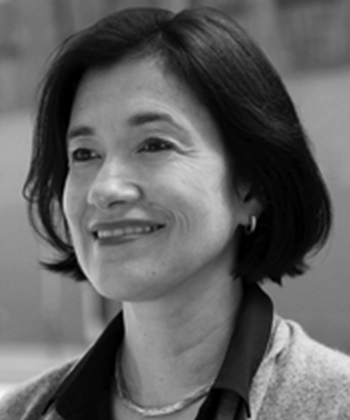
Ana Maria Llanos leads the Vancouver studio of Diamond Schmitt. Her work is focused on western Canada, including institutional, health care facilities, performing arts, residential, commercial, restoration and academic projects. Recent works includes Emily Carr University of Art + Design. She is a graduate of UBC’s School of Architecture and is rooted in the west coast lifestyle of British Columbia. ↑back
Ana-Francisca de la Mora
MRAIC, OAA ARQ, LEED AP BD+C
Associate Director – Practice Lead, Architecture, IBI Group
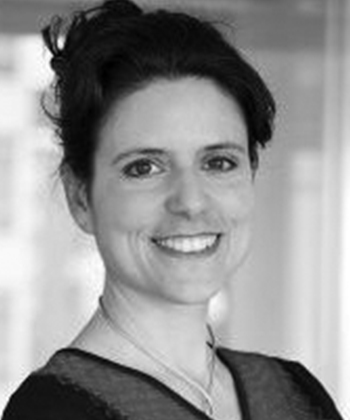
Ana-Francisca is an architect with over 18 years of experience. Her work is characterized by innovative design with a commitment to making healthy and inclusive spaces. Her work focuses on large-scale transit and Transit Oriented Development in Canada, Latin-America and Saudi Arabia. Ana-Francisca is currently leading the design and construction of the Eglinton Crosstown LRT’s Keelesdale Station, Summerhill Station Easier Access and the Richmond Hill Terminal in Toronto. ↑back
Andrew Frontini
OAA, NSAA, FRAIC, LEED® AP BD+C
Principal, Design Director, Perkins and Will
